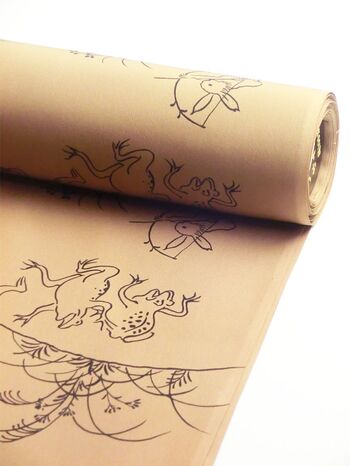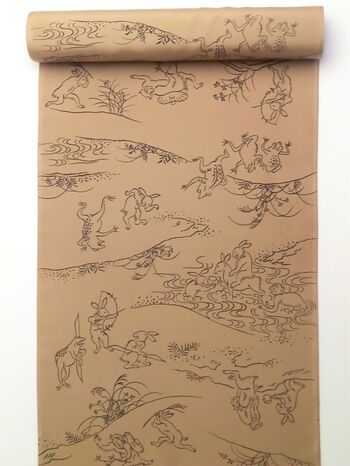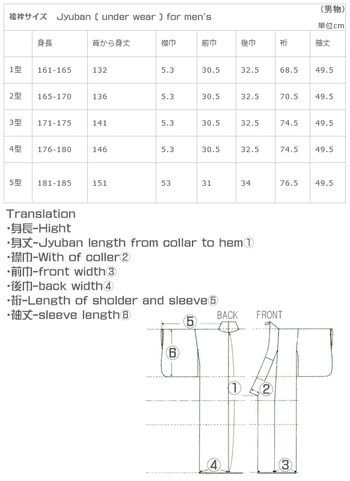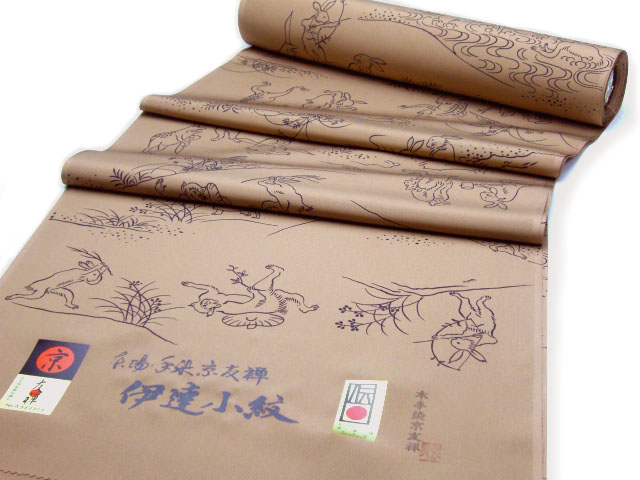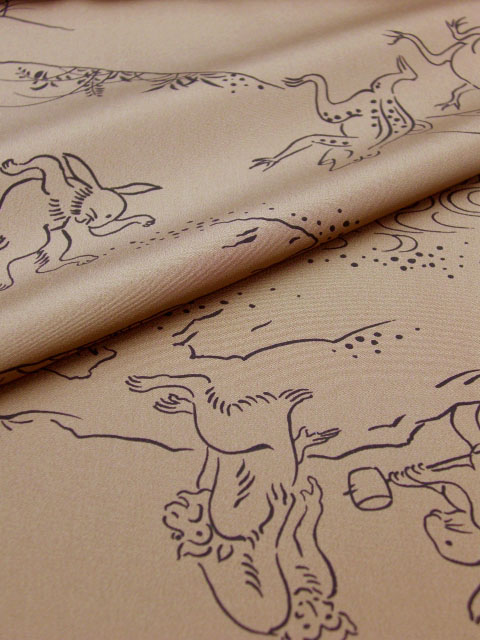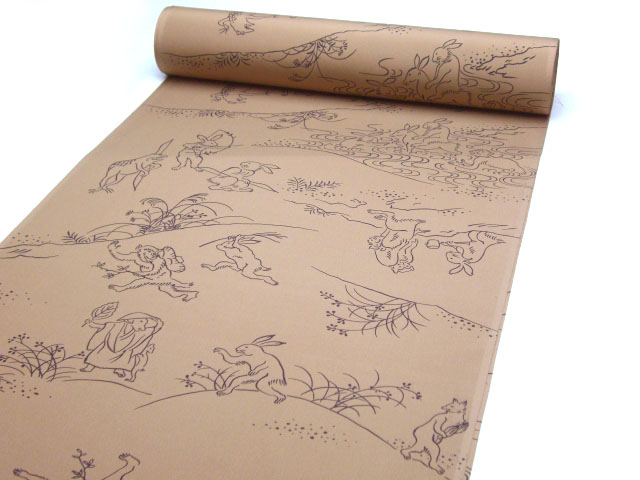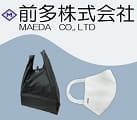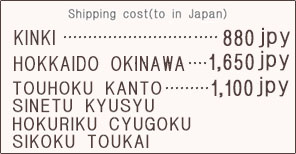 Click on the mark for details.
Click on the mark for details.This is a male undergarment with cyojyu-giga pattern.
■About the pattern of this men's undergarment
This is a design of Choju-Giga, a picture scroll at Kozan-ji Temple in Sakyo Ward, Kyoto City.
Choju Giga is properly called "Choju Jinbutsu Giga Scroll", and all four volumes are designated as national treasures.
It is considered to be the first manga in Japan.
It is properly called "Choju Jinbutsu Giga Scroll". All four picture scrolls are designated as national treasures, but none of them were created in the same period. It is said to have been made in the Kamakura period. The author is said to be Toba Sojo since ancient times.
However, the style of expression in both volumes 1 and 2 is said to be close to that of the priest's lifetime. His painting style is similar to the style of ``Ako-e'', which was said to be a satirical painting related to various subjects in the Kamakura period. It is also called Toba-e because it also draws a picture, and is considered to be the ancestor of satirical painting since ancient times.
The magnificence of this picture scroll lies in the skillfulness of its lines, which are the most expressive in the broad sense of Yamato-e.
The background of the legend of Choju Giga is that this picture scroll is kept in Kozan-ji Temple in Kyoto, and this temple was temporarily abolished in the Heian period, but in 1206 (Ken'ei 1), Myoe Shonin revived it by the order of Emperor Go-Toba. The name of the temple was changed to Kozan-ji, and it became the Konpon Gakudo of the Kegon sect in place of Todai-ji, which had become Esoteric Buddhism. However, it is said that it had many Buddhist sculptors, sculptors of Buddhist paintings, and craftsmen, as well as a workshop. I have.
The formal characteristics of this picture scroll are that, while most of the other picture scrolls are colored on paper, this one is completely white on paper, and it seems that no kotosho was prepared at all, and the whole picture scroll is continuous. It's what I'm drawing.
The size of each volume is about 30 cm in length, but the length of Volume 1 (also called Volume A) is about 1,148 cm, Volume 2 (Volume B) is about 1,189 cm, Volume 3 (Volume C) ) is about 1,130 cm, and Volume 4 (cho-roll) is shorter, about 933 cm.
The scene and content
In Volume 1 (Volume 1), a total of 103 animals such as monkeys, demons, frogs, foxes, miscellaneous children, and cats appear, all of which are anthropomorphized, bathing in the stream, playing gambling, and wearing robes. A monkey, a rabbit pulling a deer, some running away, some being chased, other animals watching the fallen frog surrounded by other animals, a frog dance, a sumo match between a rabbit and a frog, a rabbit being thrown away by a frog, and a frog on the stage. The festival, monkeys, rabbits, and foxes wear robes and recite sutras, and animal mourners watch over them, and at the end, the monkey receives blessings from rabbits and frogs. It is the most popular volume called.
Volume 2 (Volume Otsu) is not a caricature like the other volumes, but rather a map of animal ecology without a narrative plot. A total of 69 animals, including wild horses, cows, hawks, dogs, chickens, eagles, water rhinoceros, giraffes, leopards, goats, tigers, lions, dragons, elephants, and baku, have appeared. . It is also called "bird and beast sketch scroll".
Volume 3 (Volume Hei) introduces humans, and the first half depicts nine scenes: go, sugoroku, shogi, ear-biki, head-pull, glaring, fundoshi-biki, cock-fighting, and dog-fighting. . The second half has a somewhat similar theme to the first volume, depicting monkeys, rabbits, foxes, etc. imitating and playing. It is also called "Human Choju Giga Scroll".
The theme of volume 4 is somewhat similar to the first half of volume 3, and it seems to depict human society. In other words, it is a state of competitions and events of monks and lay people, such as dharma competitions, yabusame, Buddhist memorial services, and ball throwing. It is also known as a ``personal caricature volume''.
As mentioned above, the contents of each volume are varied and inconsistent, and various discussions are taking place over the interpretation of the meaning of these themes. It is considered a caricature, especially a caricature of the Buddhist world at the time. Moreover, the fact that gambling can be found throughout the book is presumed to be a satire on the secular world.
Considering the above-mentioned geography of Kozan-ji Temple, the author's intention is thought to be that he wanted to transcend the vulgarity of Kyoto in the lower world and to yearn for the world of divine immortals.
A craftsman in Kyoto plainly dyes high-quality seika made in Japan
I processed the combination of handrails.
Repeat the handrail while moving sideways,
It takes a lot of time and effort for craftsmen to dye it, and the pattern is repeated, so they use a lot of nerves.
Material: Silk
Fabric width: about 40cm
Length: about 13.0m
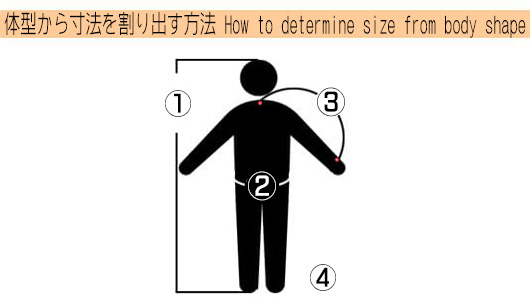
- ①「身長」/「hight」
- ②「ヒップ」または「胴回り」/「hip」or 「girth」
…胴囲の一番大きい部分です。
It is the largest part of the waist circumference. - ③「裄(ゆき)」/「Length of sleeve」
…腕を水平から下に30度まで上方に上げて、
首の後ろの骨のあたりから手首の骨まで。
首の骨のぐりぐり(第七頸椎の後ろ)から手首の骨のぐりぐりまで。
Raise your arms up to 30 degrees below horizontal, From around the back bone of the neck to the wrist bone. From the neck bone gouge (behind the seventh cervical vertebra) to the wrist bone gouge. - ④「体重」/「weight」
※襦袢の裄丈は着物の裄丈に対し約5mm短くなります。
*The sleeve length of the juban(kimono underwear) is about 5mm shorter than the sleeve length of the kimono.
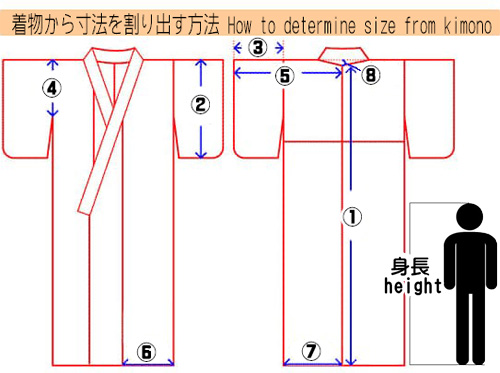
お手持ちの着物に合わせた着物や長襦袢を作りたい方は、ご自身の【身長】と、
上記図を参考に、その着物の、【①身丈・②袖丈・③袖幅・④袖付・⑤裄・⑥前幅・⑦後幅】の合計8つのサイズおを教えください。
If you want to make a jyuban(kimono underwear) that matches your kimono, please tell us your [height] and Refer to the diagram above to 【①determine the length, ②sleeve length, ③Length of sleeve, ④Width of the sleeve's seam, ⑤Length of sholder and sleeve, ⑥front width, and ⑦back width】 of the kimono.Please let me know the total 8 sizes.
※襦袢の裄丈は着物の裄丈に対し約5mm短くなります。
*The sleeve length of the juban(kimono underwear)is about 5mm shorter than the sleeve length of the kimono.













